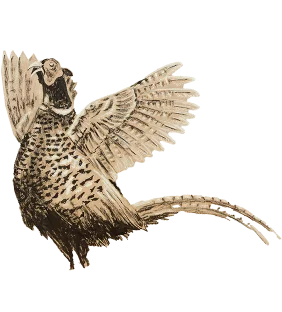Common pheasant
The original occurrence of the Common Pheasant (Phasianus colchicus) in Europe was recorded only in a small area around the Black Sea. However, from the point of view of the size of the population, we can say that its origin is in Precaucasia, in the Volga delta, in the lower regions of the Caucasus, and in the southern parts of Asia up to the Pacific Ocean.
From there, it was artificially spread throughout Europe, and North and South America in ancient times. In this vast territory, dozens of geographical races form, of which the following are especially important for us:
Common collared pheasant (Phasianus colchicus torquatus)
Phasianus colchicus colchicus (Phasianus colchicus colchicus)
Common Mongolian pheasant (Phasianus colchicus mongolicus)
Formosan pheasant (Phasianus colchicus formosanus)
Spotted pheasant (Phasianus versicolor)
Common dark pheasant (Phasianus colchicus colchicus - tenebrosus)
These breeds of pheasant have interbred and nowadays it is almost impossible to find any pure form. A pheasant (rooster) weighs 1.1 - 1.8 kg and a hen weighs 0.7 - 1.3 kg. In the pheasant, we observe significant sexual dimorphism (significant differences between males and females in size, colouring,...)
The rooster differs from the hen not only in weight but also in the distinctive, brightly coloured feathers and also has a longer tail. The red coloration of the rooster's cheeks is particularly noticeable during crowing. A pheasant can have a collar (white ring of feathers on the neck), completely or partially interrupted in front, the colour of the feathers on the chest and back can be rust-brown, dark green, or even black, depending on the breed. The rooster has well-developed spurs (rear-facing claw growths) on its feet, which increase in size with age, that is, they are significantly larger in an older rooster than in a young one. The hen is inconspicuous, its feathers are brown to ashen, and it blends in well with the environment. She has a shorter tail and rounded wings.
The habitat of the pheasant consists of woodlands, scrub belts, overgrown ditches, reeds, draws, and forest edges in the middle of agricultural land. It likes habitats with enough water (especially floodplain forests). In our country, it is widespread mainly in the West Slovak and East Slovak Lowlands, in the southern part of central Slovakia, but also elsewhere, up to an altitude of 300 to 400 m, sometimes even up to 700 m.
The number of pheasant population in the 1970s and 1980s ranged from 150 to 200,000. Currently, the number of pheasants ranges from 30-60,000. There are several factors for this sharp decline. The number of pheasants is reduced the most by agricultural technology (mowers and grain harvesters), and the enormous increase in the use of pesticides in agriculture (they reduce the resistance and fertility of pheasants and destroy some of their important food sources). In nature, they are threatened by almost all types of carnivores and predators, including larger species of owls and crow-like birds that rob their nests and hunt small pheasants. Last but not least, it is also the overpopulation of the wild boar, which threatens the pheasant in all developmental forms: from egg to adult individuals.
Pheasant hunting in the wild is one of the most attractive hunts. We often hunt pheasants with the help of hounds and dogs.
Nowadays, however, most pheasant hunts are organized in pheasant houses, where the charm of the "wild" pheasant is lost.

